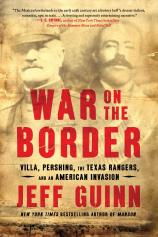Interview: May 27, 2021
In WAR ON THE BORDER, Jeff Guinn --- a chronicler of the Southwestern United States and of American undesirables (Bonnie and Clyde, Charles Manson, Jim Jones) --- tells the riveting story of Pancho Villa’s bloody raid on a small U.S. border town that sparked a violent conflict with the U.S. In this interview conducted by Michael Barson, Senior Publicity Executive at Melville House, Guinn talks about his decision to write a book about this period in Texas history, the boots-on-the-ground research he did that involved traveling as much of the border as he could during the pandemic, and the one historical figure he is so tempted to write a biography about.
Question: As a lifelong Texan, was this period of your state’s history something you grew up being interested in? Or was it the kind of hidden history that you only became aware of much later in your life?
Jeff Guinn: When the possibility of a "big, beautiful wall" became a subject of national debate during the run-up to the 2016 presidential election, I realized I didn't know much about the history of the U.S.-Mexico border. As I tried to remedy that, I learned that it's a subject of considerable complexity, and that all of our current border-related controversies and concerns date back more than a century. It seemed worthwhile to write a book providing the real history, as opposed to politically motivated alternative facts.
Q: The main thrust of your border war narrative begins in 1916, but I couldn’t help thinking of the classic movie The Wild Bunch while reading your book. That film is set in 1913 but also has the specter of Pancho Villa hovering over it. Did you derive any inspiration from that movie?
JG: I had always enjoyed watching The Wild Bunch without thinking enough about the context of its story. Now, after writing WAR ON THE BORDER, I find I like the movie even more. It’s so atmospheric --- you can almost choke on the alkali dust, and the scenery was both stark and spectacular. I wanted to bring that same sense of place to my book.
Q: You are rather famous for the amount of boots-on-the-ground research you do for your books’ different historical topics. For WAR ON THE BORDER, can you describe one or two of the most difficult investigations you conducted?
JG: I tried to travel as much of the border as was possible during the pandemic. That made "boots-on-the-ground" a lot tougher than my previous projects --- but so did the naturally rugged terrain of much of the border itself. Surprisingly, the toughest moments came in the bifurcated city of Nogales --- the border actually comprises part of its main commercial area, with the north side in Arizona and the south in Mexico. The border wall is especially massive there, and it was painful to watch people on both sides trying to touch fingers and talk through the minimal space between sharp-edged metal slats.
Q: Pancho Villa actually became a figure in American popular culture thanks to being depicted in Hollywood movies such as Viva Villa! (1934) and Villa Rides (1972), among others. But is it true that Pancho actually enjoyed watching himself in the newsreels of silent films in the ‘Teens?
JG: Villa actually sold film rights for his revolutionary battles to an American movie studio. He was less an obsessive ham than a publicity-conscious manipulator. To him, newsreels were less an exercise in self-obsession than the opportunity to impress Americans who might contribute to his cause. Villa was very calculating, though many of his hopes were dashed because of his uncontrollable temper. He was in critical ways his own worst enemy, and much different than the slapstick caricature prominent in our modern memory.
Q: If there is one discovery you made in the course of your research that ought to be included in history textbooks going forward, what example would you choose?
JG: My example would be how many times, beginning more than a century ago, the American government, state governments and individuals announced and sometimes tried to erect long border barriers to keep out unwelcome Mexicans. It never worked. Promising that it will in our current era reveals either no knowledge of relevant history or a conscious effort to either ignore or distort it. The lesson is right there in the past for anyone willing to look.
Q: In your early chapters, you touch on some of the fraught history between the United States and Mexico through the 1800s. It’s a bit of a shock to realize that the U.S. once offered Mexico $25 million for half of its territory, which stretched all the way up to Wyoming --- and ended up getting it for less than half that price!
JG: That's not nearly as shocking as the terms of the Gadsden Purchase of 1853-54. U.S. negotiators arranged for America to pay Mexico $15 million for a strip of land expanding the southern borders of Arizona-New Mexico territories. It was a firm agreement, but when the U.S. Senate voted ratification, it also voted to pay only $10 million, whether Mexico liked losing a third of the promised price or not. Mexican leaders feared that if they turned down the lower amount, the U.S. would simply annex the land, and so they reluctantly allowed America to renege. Mexico's ongoing resentment and mistrust of the U.S. is not without considerable cause. This is a good example why.
Q: It’s a given that you can’t divulge the subject of your next book, but could you reveal the historical figure you would have most liked to write a book about but feel you cannot?
JG: For many years, I've wanted to write a biography of Rosa Parks, perhaps the greatest of all American heroes. There have been a few but, to my mind, never the "readable" version she so richly deserves. Rosa was an immensely fascinating human being whose accomplishments were not limited to not giving up her seat on a bus. But it's also a fact that I'm an older white man, and critics would claim, perhaps with some merit, that I could not empathize sufficiently, even with the best of intentions. Still, I'm so tempted to try.




